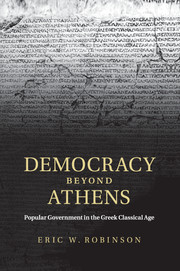Book contents
- Frontmatter
- Contents
- Figures
- Acknowledgments
- Abbreviations
- Introduction
- Chapter 1 Classical demokratiai on the Greek mainland (central Greece and the Peloponnese)
- Chapter 2 Classical demokratiai in western and northwestern Greece (plus Cyrene)
- Chapter 3 Classical demokratiai in eastern Greece
- Chapter 4 The spread of democracy in the Classical period
- Chapter 5 The nature of Classical democracy outside Athens
- Appendix Data for Figures 4.1–4.4
- Bibliography
- Index
- References
Chapter 4 - The spread of democracy in the Classical period
Published online by Cambridge University Press: 07 October 2011
- Frontmatter
- Contents
- Figures
- Acknowledgments
- Abbreviations
- Introduction
- Chapter 1 Classical demokratiai on the Greek mainland (central Greece and the Peloponnese)
- Chapter 2 Classical demokratiai in western and northwestern Greece (plus Cyrene)
- Chapter 3 Classical demokratiai in eastern Greece
- Chapter 4 The spread of democracy in the Classical period
- Chapter 5 The nature of Classical democracy outside Athens
- Appendix Data for Figures 4.1–4.4
- Bibliography
- Index
- References
Summary
As we have seen in the foregoing chapters, a great many communities in Greece were governed democratically during the Classical period. Some had relatively brief democratic interludes (e.g., Corinth and Thessaly), but most others went for decades at a time under democratic government, and several were democratic for most of the period from 480 to 323 bc. As became clear from the individual studies, certainty about the length of this or that constitutional regime is rarely attainable, since we lack anything like a continuous political narrative for the vast majority of these poleis, and only a few have even intermittent descriptions of any length. But there is enough information about enough poleis to judge that by the fifth and fourth centuries demokratia had become a widespread and persistent phenomenon in the Greek world, with examples to be found in every region of Greece from early in the fifth century to late in the fourth.
To see the truth of this at a glance, look at Figure 4.1, which illustrates the establishment and duration of demokratia in individual states grouped by region. Dark gray lines represent periods in which we can be fairly certain that democracy obtained in that city; light gray ones indicate less certainty, either about the dates or whether actual democracy existed there. (Leucas and Istrus, for example, definitely democratized at some point in the Classical period, but we do not know when, hence the long, light gray lines; Sicyon's lines are light gray because it is uncertain whether its government at the indicated times was a demokratia or not). Naturally, a chart like this loses nuance and elides ambiguities in presenting results; the individual treatments in the previous chapters, which are the basis for the results of the figures, should be sought for details regarding the basis of judgment in each case. Nevertheless, we can learn from Figure 4.1 a great deal about the general picture of democracy in Classical Greece.
- Type
- Chapter
- Information
- Democracy beyond AthensPopular Government in the Greek Classical Age, pp. 182 - 216Publisher: Cambridge University PressPrint publication year: 2011



